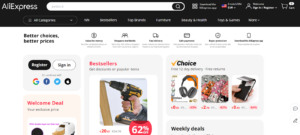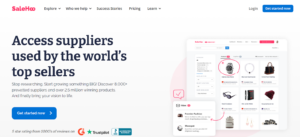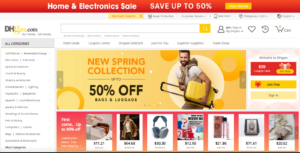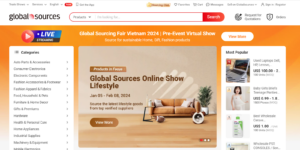The attractiveness of dropshipping lies in its simplicity and low barriers to entry. As it becomes more popular, it will be an optimal business model choice in our digital-first world. To give you an edge in this field, this tutorial will guide you on how to start a dropshipping business, journeying from niche selection to creating an online store. We will also include some insights from Cartzy, giving you real-world tips to help you start and scale your dropshipping business. E-commerce beginners or those scaling their businesses have a concise roadmap to success in dropshipping through this guide.
Definition and Explanation of Dropshipping
Dropshipping is a simplified version of the retail business model in which a store does not keep the products it sells in stock.Instead, a store buys products from third parties and has them shipped directly to customers using this model. In doing so, the merchant does not see or handle the products, unlike in traditional retail models.
Comparison with Traditional Retail Models
- Inventory Management: Traditional retailers buy inventory and stock it on their shelves until needed, and are therefore burdened by the risks of dead stock. This is eliminated in dropshipping because the products are ordered only after a purchase has been made.
- Capital Requirement: Traditional retail businesses are also costly to establish because it requires a huge initial investment in stocking. In contrast, dropshipping has less initial investment since there is no purchase of inventory in advance.
- Overhead Costs: The overhead costs for the traditional retail are high on account of storage and insurance. Only little overhead costs are incurred in dropshipping, as it does not require one to have a physical warehouse.
Advantages and Disadvantages of Dropshipping

The positive aspect about dropshipping is that it serves as an appealing model for businesspersons who wish to venture into the retail sector but with a lower capital base than what the conventional retail avenues would usually require. This is especially helpful for beginners or those who have less to work with. In addition, it provides a large number of products to choose from without the need for pre-purchasing inventory, thereby businesses can quickly respond to market trends and consumer preferences.
But despite the advantages, dropshipping also has its cons. A major drawback is the possibility of lower profitability, mainly caused by strong competition in trendy niches. This may result in a pricing race to the bottom, which can ultimately erode the company’s overall profitability.
The other important thing is relying on other suppliers, which may lead to lack of control in the inventory and shipping process. This dependence can be disappointing for the customers in case suppliers do not meet their demands and requirements. Lastly, the shipping procedures in dropshipping are complicated and expensive as well especially if orders consist of products from more than one supplier, which results to higher costs of shipping and poor logistics.
Market Research and Niche Selection

Why Niche Selection Matters: The focused niche idea enables a company to undertake market segmentation, ease inventory decisions, and promote customer loyalty. In a niche, you do not only sell products, but also work to solve particular issues or satisfy unusual wants.
Techniques for Market Research
- Consumer Demand: Identify market trends with Google Trends and Cartzy’s analytics. Look up what people are interested in at the moment on social networks.
- Competition Analysis: Use the tools provided by Cartzy to analyze competitors and identify market opportunities. Check the available comments left by customers on their websites to see what they excel in and what they lack.
- Customer Engagement: Learn more about your viewers by conducting surveys and promoting through social networks. Talk to your audience!
Examples of Profitable Niches
- Eco-Friendly Products: The popularity of sustainability in recent times makes biodegradable phone cases or reusable straws high in demand.
- Health and Wellness: Under this wide niche, it can be anything from yoga mats to nutritional supplements as they are targeting health-conscious individuals.
- Home Office Equipment: The rise of remote work makes the products that allow for better home office arrangements more and more popular.
- Personalized Items: Customizable products like personalized jewelry and accessories with monograms play on the need for uniqueness.
Finding the Right Suppliers

The right suppliers are the first and most essential requirement for establishing a profitable dropshipping business. Below is a brief guide to choosing the right partners:
Criteria for Selecting Suppliers
- Reliability: Choose the suppliers that have been tried and tested. Customer satisfaction is highly dependent on the reliability and consistency of supplies.
- Product Quality: Quality products result in reduced number of returns and more satisfied customers.
- Shipping Times: Customers’ experience can be greatly improved by reducing the shipping time. Choose suppliers who provide fast and dependable shipping services.
- Cost Effectiveness: As much as quality counts, so does cost. Strike a balance between quality and cost to keep the pricing competitive.
- Reputation: Check the reviews and ratings of suppliers. A good name is usually an indication of quality service.
Communicating with Suppliers
Strengthening the relationship with suppliers may give you attractive discounts and preferential treatments in return. Since tracking stock levels and addressing issues proactively is important, regular check-ins are critical. It is essential to have excellent negotiation skills as far as discussing terms with fairness because a lasting agreement is beneficial for both parties. Finally, a feedback loop is essential. Constructive feedback enables the supplier to grow because they can only correct the issues that they know.
Platforms for Finding Suppliers
- AliExpress: Provides a wide variety of products without any initial investment.

- SaleHoo: A suppliers’ directory with a vetting process that can be trusted.

- Oberlo: Perfect for Shopify users, ensuring easy product incorporation.

- DHgate: Offers a wide variety of products, which is good for different niches.

- Global Sources: Ideal for locating manufacturers to source products in bulk.

Building Your Dropshipping Store
There are a number of notable options to consider when choosing the right e-commerce platform. A new product in the market called Cartzy offers unique capabilities and is ideal for individuals looking to stand out. Shopify is a great platform for beginners as well as experienced users due to its user-friendly interface and robust support. Finally, WooCommerce is ideal for those who already know WordPress well since it provides a great deal of freedom and allows a lot of customization options. Every platform serves different needs, and this means that there is an option for every business model.

Key Considerations:
- Ease of Integration: Find solutions that can be easily integrated with different suppliers and tools.
- Cost-Effectiveness: Compare the pricing plans with features provided.
- Scalability: Make sure the platform is scalable for your business.
Designing a User-Friendly Website
Highlight the need for clear and simple navigation – a minimalist design will significantly improve user satisfaction! It emphasizes the importance of user-friendly navigation, which means that menus should be well-structured and that search systems should be powerful. Write clear and precise descriptions of products with everything a customer may ask to enable them to make informed choices.
Best Practices
- Mobile Responsiveness: As most of online shopping is now performed on mobile devices, a mobile-optimized layout for your store is necessary.
- Loading Speed: Optimize images and scripts for fast loading of your website.
- Engaging Visuals: You can also use clear images and videos to promote your products.
Importance of Branding
Branding is a very critical element for any business, represented mainly by a logo that should be easy to remember and correspondent with the brand’s values. The colour palette is also a significant element, as colors can be employed to cause certain emotions. A harmonized color palette can also improve brand recognition.
When it comes to brand copy, regardless of the tone that a brand uses, be it professional, conversational, or whimsical, it is this voice that defines how an organization interacts with its audience. This tone of voice needs to be maintained across all channels, further supporting the identity and values of the brand.
Why It Matters:
- First Impressions: An effective branding process helps in establishing a strong first impression as well as credibility.
- Customer Loyalty: A strong brand helps in creating a customer relationship and loyalty.
- Marketing Effectiveness: Marketing is more effective in a well-branded store.
Setting Up Business Operations
Legal Considerations
Business Registration: Do not underestimate the power of legitimizing your business! This may include registering your business name, getting a tax ID, or obtaining certain licenses depending on where you are located. It is also recommended that an individual consults their local business advisor or legal expert as each country and state have its unique requirements.
Tax Obligations: Taxes can get confusing, we know, but they are a very important aspect of your business. You should be aware of your tax obligations, be it sales, VAT, or income taxes. You might want to use some accounting software or even hire an accountant who will help you sort out your tax matters.
Setting Up Payment Gateways
Choosing the appropriate payment gateway is akin to choosing a welcome mat for your clients – it has to be pleasing and safe. Among the well-known options are PayPal and Stripe since they are easy to use and have already gained trust from consumers. The main idea here is to provide users with a seamless checkout process, and all transactions should be secured.
Managing Shipping and Returns Policies
Shipping Policies: Define shipping timelines, prices, and any restrictions on regions. Customers like seeing information on what they should expect upfrotn, so keep off from making general statements. In case you are dropshipping goods from suppliers based overseas, include the longer shipping duration and make your customers aware of this beforehand as well.
Returns Policies: Of course, returns are a part of any retail business, so don’t make it too complicated for you nor for the customer. Develop a clear and fair returns policy. Provide details of the return process, whether a customer will be responsible for shipping costs when returning an item and how long a refund or exchange takes. Customer friendly returns can be a point of competitive advantage through trust building and repeat purchases.
Marketing Your Dropshipping Business

The Power of SEO and Content Marketing
SEO is Non-Negotiable: This is the key for generating natural traffic in your store! Concentrate on long-tail keywords that align with the search intent of your target customer.
Content is King: That is, of course, if it is worthwhile and related. Inform your audience about the presence of your products and let them hear stories that they can easily relate to. This establishes trust, and when trust is established, visitors will be converted into customers.
Social Media and Email Marketing
Social Media: It is more than just uploading pictures of products. Utilize it to share the story of your brand, interact with the followers, and receive comments. You can organize contests, post behind-the-scenes of your business, and even celebrate customer experiences.
Email Marketing: This is your lifeline to customers. Divide your target audience into different segments so they can receive interest-specific messages. Welcome emails, follow-up cart abandonment messages and product recommendations are big conversion drivers.
Maximizing ROI with Paid Advertising
Google Ads: Perfect for acquisition of high-intent traffic. Use it to be seen on top of the results pages when possible clients are searching for products to purchase.
Facebook Ads: Ideal for brand awareness and retargeting. Take advantage of the powerful targeting opportunities offered by Facebook to approach individuals who share their interests online.
Customer Service and Engagement

Building Customer Trust and Loyalty: Win the confidence and loyalty of clients by being open-minded with regards to policies, customizing interactions, and ensuring consistent service provision across all platforms. The most important things are honesty, personalization, and a consistent brand voice.
Strategies for Effective Customer Service: Improve customer service by providing timely responses – perhaps even through chatbots or on dedicated lines – and training employees in empathy. A customer-focused, problem-solving attitude converts problems into opportunities.
Using Customer Feedback to Improve Your Business: Utilize customer feedback to improve, through surveys conducted often and responses analyzed for similarities. Make adjustments according to feedback received so as to indicate that the customers’ views are important and to also improve on your services.
Conclusion
In conclusion, dropshipping is an obtainable road to entrepreneurial success that requires extra careful planning but provides great benefits. Opt for a suitable niche that you would love to work with and which resonates with market demand, find good suppliers, and use such platforms as Cartzy to enhance your business operations.
The design and functionality of your online store are just as important, as well as a solid digital marketing plan. By focusing on customer service, the casual buyers can be converted into regular customers for sustainable growth.
Dropshipping is an exciting venture, and we are excited for you to take on this journey!






